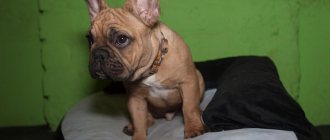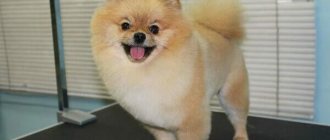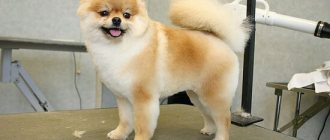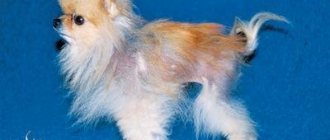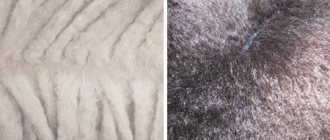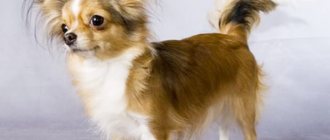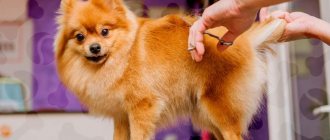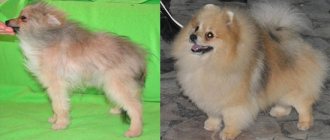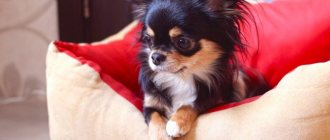About the Spitz dog breed
Spitz translated from German means “sharp, pointed.”
This is the general name for a number of dog breeds, distinguished by thick hair and a rounded tail that lies on the dog’s back, and a similar lively temperament. The Spitz's head and muzzle are similar to those of a fox. Pointed erect ears and lively eyes give them a lively, smiling expression. The ratio of the height at the withers to the length of the body in these dogs is 1:1. FCI classification
. Group 5 – Spitz and primitive dogs. Section 4 – European Spitz. They are classified as guard dogs and companion dogs.
History of the breed.
Spitz is the oldest dog breed in Central Europe. They became the progenitors of many other breeds. Initially, these were large dogs weighing about 30 kg, which were not considered purebred at all and they inhabited mainly cold, snowy regions. Their “primitive” type of coat saved the dogs from cold, moisture and winds. In England, the wife of George III brought from Pomerania a small representative of these white dogs, and later her granddaughter began to breed them, trying to reduce their size. Around the same time, the selection of German Spitz dogs of various sizes began.
Main varieties of the breed.
In European countries under the auspices of the FCI and in Russia, the breed is called the German Spitz and has several height categories: Wolfspitz (Keeshond) - the largest, height at the withers 45-55 cm; large Spitz (grossspitz) – 42-50 cm at the withers; average Spitz – 30-38 cm; small Spitz (Kleinspitz) – 23-29 cm; miniature Spitz (Zwergspitz) - 18-28 cm, which also includes Pomeranian Spitz. The dog's weight should correspond to its height.
In the countries of the USA, Canada, and Great Britain, the Pomeranian Spitz is classified as a separate category, because... was bred by man and has a number of differences from German Spitz dogs in coat structure, constitution, etc. They come in miniature, small and medium and should weigh 1.5-3.5 kg.
The German Spitz has relatively close-set ears, a pointed muzzle of the “fox cub” type, the transition from the forehead to the muzzle (the so-called STOP) is moderately pronounced and blurred. The dental formula is complete - 42 teeth and a scissor bite. The position of the forelimbs has an inclination of the pastern at an angle of 20 degrees. The dog's tail is curled into a ring on the back, possibly a double ring.
The coat color is very diverse: black, brown, white, orange, zone-gray - typical of the Keeshond (silver-gray with black tips).
The coat is double: long, straight, non-adherent outer coat, or guard hair, and a short, cotton-like, slightly wavy undercoat.
The Pomeranian Spitz has small ears set wider than those of the Germans, a short muzzle with a clearly defined transition from forehead to muzzle, an upturned black nose, and large eyes.
Based on the shape of the head and the structure of the muzzle, Pomeranians are sometimes divided into “baby doll”, or toy type, bear-type Spitz and the main type – “fox”, which are most common in Russia. The first 2 types have a rounder and larger head, rounded, not always erect, ears, and pronounced cheeks.
In Pomeranians, partial teeth with the absence of premolars are allowed.
The placement of the forelimbs of these dogs is special - the metacarpus is located almost vertically, almost at an angle of 90 degrees. The tail lies on the dog's back and does not form rings.
Wool. The coat color of Pomeranians is mostly red with different shades, but there can be other colors, including combined ones.
The wool structure is double. There is little or no guard hair. The undercoat is long, cotton wool-like, spiral-shaped, springy.
Temperament.
All Spitz dogs are distinguished by their attentive gaze, lively character and devotion to their owner. They are intelligent, easy to train, and have excellent guard qualities. Not timid, but not aggressive either.
Health.
Spitz dogs are distinguished by good health and longevity (up to 14 years or more). Health problems most often occur in the dwarf variety, the Pomeranian. The most common problem, as with all decorative dogs, is periodontitis, a disease of the mouth and gums with the formation of tartar, an unpleasant odor and subsequent loosening and loss of teeth. If a problem arises, it is necessary to brush the Spitz’s teeth, perhaps by an experienced groomer in a pet salon, without anesthesia, and in advanced cases, you must contact a veterinary dentist. Oranges have skin diseases - alopecia (baldness), joint problems - subluxations due to weak ligaments. Also, obesity and its complications, and inflammatory eye diseases often occur.
Features of Spitz dogs
Spitz are short dogs with a plush coat and a luxurious “lion’s mane” that turns the pet into a teddy bear. Volume is provided by a thick undercoat with coarse hair growing perpendicular to the skin.
The breed has arctic-type wool: it regulates air exchange near the skin, protects from cold in winter and from overheating in summer. Its condition depends on vitamins in the diet, properly selected shampoos, walking conditions and regular grooming of the Spitz. Without proper care, tangles quickly form, and guard hair begins to fall out with the formation of bald areas. The most problematic areas: the crotch, armpits between the legs, ears.
The fine down begins to give way to mature, coarse hair at 4 months after the first molt. The peak of fall is observed in spring and autumn during the off-season. Complete replacement with the appearance of the final shade ends by 3 years.
Thanks to the unique structure of the coat, the process of molting in a Spitz is almost invisible to its owners. The sparse guard hairs remain in the thick layer of fur after falling out and therefore require careful combing. Their shortening and neat edging make them easier to care for.
Features of wool
The Spitz resembles a small teddy bear with button eyes and a beautiful collar. This effect is achieved due to the abundant soft undercoat and stiffer long hair. Thanks to the dense undercoat, the awn is held perpendicular to the skin, giving a rounded silhouette.
In order for the pet to remain “plush”, it is necessary to carry out grooming - caring for its appearance. Regular procedures include brushing once a week. Frequent brushing can lead to the loss of most of the undercoat, causing the pet to become “smooth” because... The guard hair will fall off, or even develop unsightly bald spots. When combing, more careful attention should be paid to the ears, armpits, and crotch. These places are most susceptible to the formation of tangles.
Grooming your Pomeranian is necessary to give it shape and is done every two to three months. After the procedure, the pet becomes a real beauty with even, smooth, well-groomed fur. You can cut only the ends or make a model haircut that suits a specific pet. Grooming a German or any other Spitz is carried out according to a single algorithm .
Rules for caring for Spitz hair
When carrying out grooming, it is important to take into account the characteristics of your pet’s coat:
- Spiral-shaped guard hairs lift the coat, so voluminous “air” haircuts are preferred.
- Every day you need to thoroughly comb your dog with a soft brush, paying special attention to the neck, groin area and belly of the animal. It is necessary to use special conditioners that reduce the number of tangles.
- The dog should be bathed no more than once a month at a water temperature of 34-36°C, be sure to dry it with a hairdryer using a stream of cool air, and comb it with a slicker brush.
- Use only high-quality and certified feed: the quality of wool depends 60% on the received nutrients, mineral compounds and vitamins.
During the first months, it is better to choose a simple hygienic haircut. Gradually, the dog gets used to grooming and reacts calmly to nail trimming. If necessary, young Spitz dogs undergo express molting.
Shedding in Spitz dogs
The first molt occurs at 3-4 months. The pet's appearance changes noticeably. During this period, guard hair appears, and the down is replaced by a permanent coat of hair. Until two or three years of age, the volume of fur constantly increases, and by three years the fur coat is fully formed and stops growing and shedding intensively. By this time, you can choose any show hairstyle for your pet.
Adult Spitz dogs shed twice a year, gradually shedding their guard hair and undercoat. Spitz shed quite slowly, because... the undercoat delays the hairs, and there is no need to worry about wool scraps around the house. However, it is necessary to remove dead hairs, so during the shedding period, the Spitz is combed several times a week. A well-groomed, short-haired Spitz practically does not shed.
Main types of Spitz haircuts
The choice of haircut for a Pomeranian or German Spitz depends on the wishes of the owner, size and gender, and time of year. The most popular and recommended by groomers models:
| Spitz show haircuts photo | Description of exhibition haircuts |
| Classic or show grooming of a Spitz . Regulated by the breed standard. The specialist’s task is to highlight the animal’s advantages and carefully hide its shortcomings. Using thinning scissors, the ears and cheeks are given a rounded shape. The paws and collar are made more spherical. The tail should resemble a fan, so the groomer leaves the length by trimming the excess in the anus and groin area. | |
| Hygienic spitz haircut . A simple option for connoisseurs of naturalness. Helps avoid problems with care at home. The pet's undercoat is thoroughly combed to remove tangles and matted tufts. The dog is carefully removed 2-3 cm on the front and hind legs, near the anus; make ears more rounded, remove protruding hairs at the tips. The specialist carefully walks at the base of the tail so that it curls beautifully and rests on the withers. |
Before grooming, the Spitz must be bathed using special hypoallergenic products and dried, trying to blow out the undercoat during the drying process. The work begins with the head, gradually moves to the torso, and ends with the treatment of the anal area.
Which dog is suitable for "Little Fox"
The most important rule is to cut “fox-like” better than fox-type oranges. These minis make excellent fox cubs. Some breeders ask groomers to make a fox cub from a Bear Spitz, but usually the result is not very good. The dog becomes cuddly and bears little resemblance to a red fox.
Bear or fox
Grooming experts argue that the shape of the muzzle and the quality of the fur are different among the subspecies. In this form, it is quite easy to distinguish a dog from a fox.
At the same time, regardless of the result, you will pay a rather high price, but you will not achieve the desired result. A haircut can cost from 1.5 thousand rubles.
Model haircuts for Spitz
Beautiful and fluffy wool allows the owner to choose a non-standard model haircut for the Spitz. In the salon, an experienced groomer can perform the following options:
| Model haircuts for Spitz photos | Description of model haircuts |
| Under the fox . Recommended for the “German”, it emphasizes the slightly elongated skull and sharp muzzle. The ears are given a triangular shape and long hairs are removed. The collar is shortened to the same length as the body, the tail is left unchanged, slightly removing the fluff at the tip. | |
| Stylish pixie . The body and paws are carefully trimmed with scissors, leaving a plush layer, the collar and cheeks are removed by 5-6 cm. The head takes on a spherical shape, the ears remain fluffy after light trimming. | |
| Toy Terrier or Toy . The ideal haircut for a fox-type Spitz: the master removes the length of the entire body to 2.5-3 cm, cuts the tail, and gives the ears the appearance of a triangle. The collar area is completely removed, exposing the neck. The groomer tries to achieve maximum resemblance to the decorative breed, shortening the cheeks so that the muzzle acquires lighter features. | |
| Grooming a spitz or a teddy bear . Characteristic signs: ears and tail should be at the same level, hair on the body should be removed short. They become plush to the touch. The paws are given an elegant “cat” shape. After the groomer's work is completed, the pet resembles a soft toy. Among the disadvantages is that the animal is not allowed to be exhibited because the breed does not meet the standards. The coat takes several months to grow, and the condition of the undercoat deteriorates. | |
| Modern . It is based on the classic one, emphasizing the elegance of the breed, but the master shortens the length more. The groomer gives the silhouette a smooth outline with a deep edging of the body, which guarantees a plush effect to the pile. The ears and muzzle should be round with no protruding hairs. When done professionally, it does not harm the structure of the Spitz's coat. |
When choosing a haircut model, there are no strict recommendations regarding the gender of the dog. But most owners avoid giving a girl a spitz haircut to look like a bear or a lion: the classic one looks more elegant, emphasizing the exterior and color features.
But specialists from the ARTEMONoff grooming salon warn that short haircuts for a Spitz like a bear cub or a fox can lead to disruption of the growth of the undercoat. When using a machine or shortening it too much, the guard hairs fall out more actively, and the new bulbs gradually “fall asleep”, and bald patches and bald spots appear on the back, stomach, anal area and paws.
Alopecia X is a serious problem that is accompanied by changes in skin pigmentation. Therefore, before choosing a haircut for a Pomeranian, you need to consult a groomer and choose from standard classic options.
The cost of grooming a Spitz depends on the set of procedures. It is complemented by washing, combing out stray lumps, shortening claws and trimming. After removing the fallen guard hairs, the coat becomes smooth, has a healthy shine, and the amount of hair on the furniture and clothes of the owner decreases. The risk of inflammation and dermatitis, which are complicated by skin irritation, is reduced.
Do I need to trim my Pomeranian?
The Spitz standard does not provide for cutting requirements. His coat must be thick, long and natural, and if this rule is violated, the dog will not be able to be judged at the show. Haircut is usually used for decorative purposes or to make grooming easier.
Some owners are afraid that the dog will suffer from the heat, so they shorten the hair. However, it should be noted that the dog cools itself through breathing, opening its mouth and sticking out its tongue. The presence or absence of fur does not greatly affect this indicator.
Removing hair exposes the skin to sunburn, wind, cold and mosquitoes. In addition, short hair gets dirty faster; the dog will have to be bathed often, which can make the coat brittle and unkempt. After a short haircut, Spitz hair grows slowly, and mechanical alopecia may occur.
It should be noted that on cut wool, tangles and tangles occur less often, and the guard hair almost does not break. After the procedure, the pet looks neat, the cover does not interfere with its physiological actions and movement. In addition, model haircuts make the Spitz original and attract the attention of others.
Basic rules for cutting Spitz dogs
It is necessary to know the peculiarities of the structure and renewal of hair in order to make an even edging and not disturb the nutrition of the roots, therefore it is not recommended to cut your pet’s hair at home. In the salon, the specialist uses high-quality tools, combs and slickers, disinfectant solutions, hypoallergenic products with antistatic action.
There is no need to cut your pet's hair yourself: if it is accidentally damaged or shaving is too short, the hair growth will not be restored. The consequence of unprofessional grooming of Spitz dogs is mechanical alopecia, long-term and expensive treatment. The master carefully checks the length and direction of the villi during work, so as not to disrupt the process of thermoregulation of the skin, not to provoke sunburn in the summer and frostbite in the cold.
At the ARTEMONoff salon in Moscow, Spitz haircut prices are quite affordable for all owners of these charming dogs. The cost is affected by the range of services chosen. We adhere to strict sanitary standards and requirements, which eliminates injury and infection during procedures. Masters do not use sedatives to calm pets, trying to find an approach to the most impatient four-legged clients.
Spitz fox and bear: differences
If you compare a fox and a bear cub, you can highlight the following differences:
- The bear haircut is more “extreme”; the hair is shaved quite short.
- They cut the baby “bear-like” with a clipper, using scissors only to trim the pile.
- The muzzle of a bear cub is made more round, and that of a fox is made “elongated”.
- In the first case, the tail is practically shaved off, and in the second, it is made to look like a fox's.
- And the most important difference. After a hairstyle like Boo, the fur takes a very long time to grow, and its quality suffers. Fox grows faster and the quality practically does not change.
Both of these varieties will not allow the breeder to exhibit the pet at shows.
Prices for Spitz haircuts:
| Breed | Wash dry | Short haircut | Grooming long hair | Tangles (RUB/hour) | Complex |
| Spitz medium (Japanese) | 2500 rub. | 1600 rub. | 1600 rub. | 300-600 rub. | 3500-4000 rub. |
| Pomeranian Spitz (up to 23 cm) | 2000 rub. | 1500 rub. | 1500 rub. | 300-600 rub. | 2600 -3200 rub. |
| Small German Spitz (23-28 cm) | 2500 rub. | 1500 rub. | 1500 rub. | 300-600 rub. | 3000 -3600 rub. |
| Spitz (keeshond) | 2700 rub. | 1700 rub. | 1700 rub. | 300-600 rub. | 3800-4600 rub. |
Spitz grooming: description of the procedure
Grooming a Spitz begins with combing the coat, hygiene procedures are carried out, such as cleaning the ears, trimming and filing the claws, and trimming the hair between the pads on the paws. This procedure is necessary to get rid of tangles, which mainly collect in the groin, ears, and armpits.
Bathing is multi-stage, cosmetics are selected according to the type of coat, as well as taking into account individual characteristics. Dry the wool using a professional compressor hair dryer. When the dog is combed, the coat is noticeably moisturized and nourished, the groomer begins cutting. Using minimal cuts, the master draws out the breed lines, giving the dog a unique look.
Grooming of a Spitz puppy should begin at 3 months. This is an important stage for accustoming the dog first to hygiene procedures, and later to a haircut.
Some of our works:
Grooming a Pomeranian dog
Spitz haircut in the ARTEMONoff salon
Pomeranian Spitz after haircut
Spitz haircut
Spitz grooming in the ARTEMONoff salon
Classic Spitz haircut
Pomeranian Spitz Grooming
Spitz grooming
See all photos of dog haircuts in the photo gallery >>>
How to perform the procedure yourself
Haircut like a fox is quite complicated in technique, but if you follow certain rules and watch training videos, you can do it yourself:
- Carefully trim the fur around the root of the tail, making it look like a fox.
- Remove excess hair from the dog's ears, collar area and paws. Carefully remove any lint from between your fingers.
- Align the fur along its entire length so that individual hairs do not stand out from the overall picture.
You can trim your Spitz with scissors or a professional clipper. To carry out the procedure yourself, prepare single-sided thinning scissors and scissors with blunt ends. You also need a massage brush and a comb with metal teeth.
Grooming should be done regularly to keep your pet looking neat.
Chanterelle
Important ! Never cut your dog's head, otherwise the hair may not grow back.
Why is grooming a necessary procedure for Pomeranian and German Spitz?
Grooming is an extremely important part of keeping your pet healthy. Without care and maintenance, the undercoat will quickly form into dense tangles, which will not allow the skin to breathe normally.
It is extremely important to choose the right groomer, since mistakes made will take a very long time to correct. The Grooming House salon provides professional grooming services for dogs. Our masters will individually select high-quality cosmetics for your pet, and will also carry out a comprehensive haircut of the Spitz, cleaning of the paraanal glands, blow-drying using protective and caring sprays, and filing the claws. The price of cutting a Spitz, as well as all grooming procedures, varies from 2,500 to 3,500 rubles, depending on the type of breed and the type of procedure.
Problems that arise when cutting
It is not difficult to give your dog a hygienic haircut. They simply give it a well-groomed appearance by shortening any stray hairs. Problems arise with exhibition and model haircuts. Their creation requires experience. Without undergoing grooming training, this is quite difficult to do. The procedure becomes a real test for the owner of a German Spitz - the dog resists and resists. Screams and threats against him do not help. The baby develops a negative attitude towards the process. To avoid getting this result, you should call a specialist at home or go to a specialized salon.

